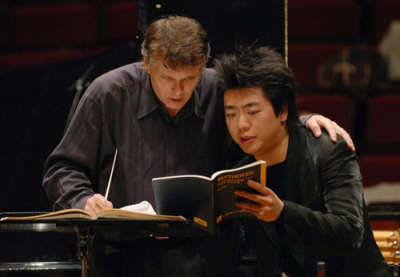Bavarian Radio SO in New York (III):
Lang
Lang, Piano,
Bavarian Radio Symphony Orchestra, Mariss Jansons, Chief
Conductor, Carnegie Hall, New York City, 05.11.2006
(BH)
Rolf
Liebermann:
Furioso
(1947)
Beethoven:
Piano Concerto No. 1 in C Major, Op. 15 (1795)
Sibelius:
Symphony No. 2 in D Major, Op. 43 (1901-02)

Mariss
Jansons sure knows how to throw a party. Tonight’s
concert, one of the highlights of the fall season, was
notable for including not one, but three encores, including
Lang Lang’s stunning “Spring Dance” that followed his
impressive Beethoven First Piano Concerto.
Kicking
things off was Rolf Liebermann’s Furioso, which
from 1947 was the second-newest item on all three programs.
(Strauss’ Four Last Songs from 1948 barely eased
into first place.) Liebermann was primarily known
as an audio engineer and orchestra administrator, but
found enough time to create operas, cantatas and other
works, including this bristling little exercise.
It opens with rapid-fire runs in the strings, shivering
up and down like tiny electric eels, with a prominent
piano part done commandingly by the orchestra’s Barton
Weber. The middle section could be lyrical Prokofiev,
stirred with a bit of Bernstein. It was all highly
enjoyable, and the Bavarian Radio ensemble played it as
if they might never again have the opportunity to show
it to an American audience.
I’ve
now heard Lang Lang live twice, and while I can still
sense the skepticism of some who think he has been marketed
out of existence, it is clear that he is a piano virtuoso
of the first order. If the Beethoven occasionally
seemed a study of willful accents almost to the point
of parody, this was more than offset by some crystal-clear
phrases, even at low volumes, and an intense rapport with
Jansons and the orchestra. In the second movement
the pianist’s articulation was virtually faultless.
After starting the final Rondo at super-high speed, some
of the middle section had the jazzy ease of Scott Joplin,
and there was simply nothing to complain about Lang Lang’s
poise, confidence and control, making every single moment
sing to the heavens. And thankfully there was little
“looking to the heavens” as has been noted in some of
his performances, but now I’m already prepared to simply
glance away, should his body language become more of a
liability than a show of empathy. On this occasion,
at least, it wasn’t a problem. The orchestra, similar
to the Beethoven Seventh Symphony the previous night,
summoned up some exuberant, danceable rhythms that only
underlined the camaraderie onstage.
I
continue to think that some of Lang Lang’s choices, like
this concerto, are simply too easy for him. (Rest
assured this is no oblique comment on Beethoven.)
But I wish something by Xenakis or Ginastera would catch
his eye – a furiously wild piece that would fully engage
his astounding technique. We got a brief glimpse
of what that might entail with a brilliant encore, a traditional
Chinese melody arranged as if carved up in a war between
Conlon Nancarrow and Tan Dun. The fairly traditional
sounding opening is soon eclipsed by a violently showy
center, with blitzes of notes splintering all over the
place at high speeds, before the piece returns to some
semblance of calm with an enigmatic final chord that could
have been lifted from a Scriabin sonata. Lang Lang
could do the piano world an inestimable service by starting
the process of considering commissioning some works from
living composers, who could challenge his talents to heights
I can only imagine.
From
the first few bars of the Sibelius Symphony No. 2, one
could tell that a mesmerizing reading was in store, with
Jansons adeptly capturing that uniquely Sibelian feeling
of being buoyed along on gusts of wind. Just when
the music seems calm, the strings whip up things into
a climax, the winds tossing about in glittering good humor.
The second movement, with some notable work from Eberhard
Marschall and Marco Postinghel on bassoon, seemed to rise
up as if summoned by an ancient incantation. The
sprightly third movement, the windiest of all, was given
a true vivacissimo, light as silk, before the finale
strode into view, preening in that curious Sibelius mix
of haze and sunlight. This was quite simply one
of the most breathless yet coherent views of this warhorse
I have ever experienced, with Jansons taking full advantage
of every magnificent phrase, shaping each one as if it
mattered more than any of the other repertoire in the
three evenings.
With
a cheering audience as backdrop, Jansons waited until
the room was completely quiet to begin the haunting opening
of Sibelius’ Valse triste, whose admirers must
have been floored with the colors cracked open in the
middle. The evening ended with the final waltz from
Richard Strauss’ suite from Der Rosenkavalier,
giving those who didn’t hear the whole thing on Friday
a glimpse of what they missed.
Bruce Hodges
Photo ©
Michel Neumeister



